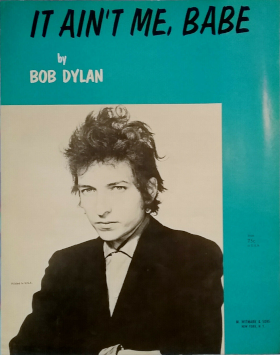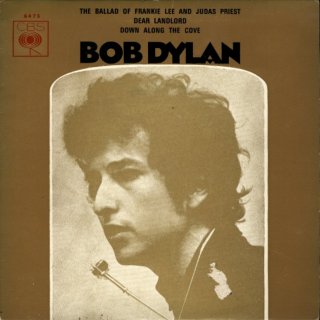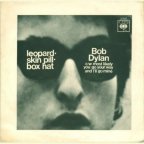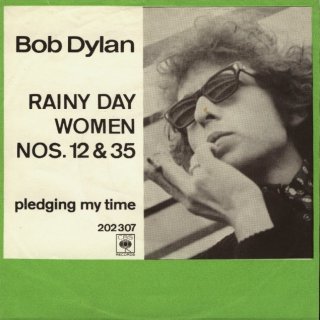Related Research Articles

"It Ain't Me Babe" is a song by Bob Dylan that originally appeared on his fourth album Another Side of Bob Dylan, which was released in 1964 by Columbia Records. According to music critic Oliver Trager, this song, along with others on the album, marked a departure for Dylan as he began to explore the possibilities of language and deeper levels of the human experience. Within a year of its release, the song was picked up as a single by folk rock act the Turtles and country artist Johnny Cash. Jan & Dean also covered the track on their Folk 'n Roll LP in 1965.
"4th Time Around" is a song by American singer-songwriter Bob Dylan, which was released as the 12th track on his seventh studio album Blonde on Blonde on June 20, 1966. The song was written by Dylan and produced by Bob Johnston. Commentators often interpret it as a parody of the Beatles' 1965 song "Norwegian Wood ". John Lennon composed "Norwegian Wood" after being influenced by the introspective lyrics of Dylan. Lennon later reflected on his feelings of paranoia when Dylan first played him "4th Time Around".
"Absolutely Sweet Marie" is a song by American singer-songwriter Bob Dylan, which was released on the third side of the double album and Dylan's seventh studio album, Blonde on Blonde (1966). The song was written by Dylan and produced by Bob Johnston. It was recorded at around 1:00 am on March 8, 1966, at Columbia Studio A, Nashville. Some commentators have interpreted the song as being about sexual frustration.

"The Ballad of Frankie Lee and Judas Priest" is a song by American singer-songwriter Bob Dylan. It was released as the fifth track on his eighth studio album John Wesley Harding (1967). The track was written by Dylan and produced by Bob Johnston. It was recorded in one take on October 17, 1967, at Columbia Studio A in Nashville. The song's lyrics refer to two friends, Frankie Lee and Judas Priest. Lee asks Priest for a loan of money and Priest offers it freely. Lee spends it in a brothel over 16 days, then dies of thirst in Priest's arms. It has been suggested by commentators that the song refers to Dylan's relationship with his manager Albert Grossman or to his contractual negotiations with his record company. The song received a mixed critical reception. Dylan performed the song live in concert 20 times, from 1987 to 2000.

"Leopard-Skin Pill-Box Hat" is a song by the American singer-songwriter Bob Dylan, which was released on the second side of his seventh studio album Blonde on Blonde (1966). The song was written by Dylan, and produced by Bob Johnston. Dylan has denied that the song references any specific individual, although critics have speculated that it refers to Edie Sedgwick, who Dylan had spent time with in December 1965.
"Tombstone Blues" is a song by American singer-songwriter Bob Dylan, which was released as the second track on his sixth studio album Highway 61 Revisited (1965). The song was written by Dylan, and produced by Bob Johnston. Critical interpretations of the song have suggested that the song references the Vietnam War and US President Lyndon Baines Johnson.

"Stuck Inside of Mobile with the Memphis Blues Again" is a song by American singer-songwriter Bob Dylan from his seventh studio album, Blonde on Blonde (1966). The song was written by Dylan and produced by Bob Johnston. It has nine verses, each featuring a distinct set of characters and circumstances. All 20 takes of "Stuck Inside of Mobile with the Memphis Blues Again" were recorded in the early hours of February 17, 1966, at Columbia Records's A Studio in Nashville, Tennessee, with the last take selected for the album. This version also appears on Dylan's second compilation album, Bob Dylan's Greatest Hits Vol. II (1971).
"Talkin' New York" is the second song on Bob Dylan's eponymous first album, released in 1962. A talking blues, the song describes his feelings on arriving in New York City from Minnesota, his time playing coffee houses in Greenwich Village, and his life as a folksinger without a record deal. The lyrics express the apparent difficulty he had finding gigs as a result of his unique sound, with a character in the song telling Dylan: "You sound like a hillbilly; We want folk singers here."

"I Want You" is a song by the American singer-songwriter Bob Dylan, which was released as a single in June 1966, and, later that month, on his seventh studio album, Blonde on Blonde. The song was written by Dylan, and produced by Bob Johnston. The song has been interpreted as a straightforward expression of lust, although critics have highlighted that the symbolism of the song is complex. It was the last song recorded for Blonde on Blonde, with several takes recorded in the early hours of March 10, 1966. It was included on Bob Dylan's Greatest Hits (1967). The song has received a largely positive critical reception, with a number of commentators highlighting Dylan's use of imagery, although some of the meanings are obscure.

"Pledging My Time" is a blues song by American singer-songwriter Bob Dylan from his seventh studio album, Blonde on Blonde (1966). The song, written by Dylan and produced by Bob Johnston, was recorded on March 8, 1966 in Nashville, Tennessee. Dylan is featured on lead vocals, harmonica, and guitar, backed by guitarist Robbie Robertson and an ensemble of veteran Nashville session men.
"To Ramona" is a song by American singer-songwriter Bob Dylan, first released on his fourth studio album, Another Side of Bob Dylan (1964). The song was written by Dylan, and produced by Tom Wilson. The lyrics were started at the May Fair Hotel in London in May 1964, and finished during a week-long stay in the Greek village of Vernilya later that month. Dylan recorded all the tracks for the album, including the song, in a single three-hour session on June 9, 1964, at Studio A, Columbia Recording Studios, New York. Its narrator advises Ramona, who is preparing to return to "the South", not to follow the advice of others. Critics have suggested several different people as inspirations for the song, including Joan Baez, Suze Rotolo, and Sara Lownds.
"John Brown" is a song by American singer-songwriter Bob Dylan. The song, written in October 1962 was released under his pseudonym "Blind Boy Grunt" on the Folkways Records compilation album Broadside Ballads, Vol. 1 (1963). Live performances have been officially released on MTV Unplugged (1995), Live at The Gaslight 1962 (2005), and Live 1962–1966 – Rare Performances From The Copyright Collections (2018). A demo version was issued on The Bootleg Series Vol. 9 – The Witmark Demos: 1962–1964 (2010).

"Obviously 5 Believers" is a song by American singer-songwriter Bob Dylan, which was released as the last track of side three of his double album Blonde on Blonde (1966), and was the B-side to the single release of "Just Like a Woman" for releases in America and some other countries. The song was written by Dylan and produced by Bob Johnston. It was recorded at Columbia Music Row Studios, in the early morning hours of a March 9–10, 1966 session. Four takes were recorded, although the first two were incomplete. It has been interpreted as a blues song about loneliness, with critics noting similarities in melody and structure to Memphis Minnie's "Chauffeur Blues". Dylan's vocals and the musicianship of the band on the track have both received critical acclaim, although the track has been regarded as insubstantial by some commentators.
"Temporary Like Achilles" is a song by American singer-songwriter Bob Dylan that was released on side three of his double album, Blonde on Blonde (1966). The song was written by Dylan, and produced by Bob Johnston. It was recorded at Columbia Studio A, Nashville, Tennessee on March 9, 1966. The song is a blues number that incorporates elements of Dylan's incomplete "Medicine Sunday", which he had recorded with members of the Band in New York in October 1965. The song describes a narrator's frustration at being kept waiting by a woman that he wishes to be romantically involved with, who is guarded by "Achilles". Some critics have suggested that the song references the Iliad.
"I Shall Be Free" is a song by American singer-songwriter Bob Dylan. It was recorded on 6 December 1962 at Studio A, Columbia Recording Studios, New York, produced by John Hammond. The song was released as the closing track on The Freewheelin' Bob Dylan on 27 May 1963, and has been viewed as a comedic counterpoint to the album's more serious material. Dylan has never performed the song in concert.
"Down the Highway" is a song by American singer-songwriter Bob Dylan. It was recorded on July 9, 1962 at Studio A, Columbia Recording Studios, New York, produced by John Hammond. The song was released on The Freewheelin' Bob Dylan on May 27, 1963. It is a twelve-bar blues love song, which Dylan told his girlfriend Suze Rotolo he had written about her.

"One More Cup of Coffee (Valley Below)" is a song by American singer-songwriter Bob Dylan, which was released as the fourth track on his seventeenth studio album Desire (1976). The song was written by Dylan, and produced by Don DeVito. The album version of "One More Cup of Coffee (Valley Below)" was recorded on July 30, 1975, and released on Desire in January 1976. Dylan said the song was influenced by his visit to a Romani celebration at Saintes-Maries-de-la-Mer in France on his 34th birthday.
"You're No Good" is a song by Jesse Fuller that appeared as the opening track on Bob Dylan's eponymous debut album (1962). Eight takes were recorded by Dylan on November 20, 1961. He learnt the song directly from Fuller in Denver; Fuller's own recorded version was not released until May 13, 1963, on his album San Francisco Bay Blues. The song concerns the narrator's difficult relationship with a woman, and concludes with the narrator wanting to "lay down and die". Dylan's version is more uptempo than Fuller's, and has some changes to the lyrics; it has been positively reviewed by critics.
"Highway 51 Blues" was the title of a song composed by American blues pianist Curtis Jones, released on a 78 record on January 12, 1938, which was popular enough to spawn several covers and offshoots, including "New Highway 51," recorded in 1940 by the Mississippi guitarist and singer Tommy McClennan. Bob Dylan's track "Highway 51", released as the closing track of the first side of his debut album Bob Dylan on March 19, 1962, was based on McLennan's recording.
References
Citations
- 1 2 3 Hampton 2020, p. 80.
- ↑ Heylin 2010, p. 199.
- 1 2 Heylin 2021, p. 358-360.
- ↑ Heylin 2011, pp. 155–157.
- ↑ Heylin 2011, p. 158.
- 1 2 3 Heylin 1995, pp. 29–32.
- ↑ Margotin & Guesdon 2022, p. 123.
- ↑ Björner, Olof. "1964 concerts, interviews and recording sessions". Still on the Road. Retrieved September 17, 2022.
- 1 2 Margotin & Guesdon 2022, p. 122.
- 1 2 3 Nogowski 2022, p. 46.
- ↑ Trager 2004, p. 14.
- ↑ Whitall, Susan (10 May 1995). "Multimedia music creates options, hassles". The Desert Sun. p. B2.
- 1 2 3 "I Shall Be Free No. 10". Bob Dylan's official website. Retrieved September 17, 2022.
- ↑ "Bob Dylan – The Original Mono Recordings". Uncut . October 29, 2010. Retrieved August 8, 2023.
- ↑ Browne, David (August 8, 2016). "How Bob Dylan shed his spokesman role on 'Another Side'". Rolling Stone . Retrieved July 28, 2022.
- ↑ Trager 2004, pp. 598–599.
- 1 2 3 4 5 6 Gray 2008, p. 340.
- 1 2 Curtis 1987, p. 158.
- ↑ Hartman 2019, p. 54.
- ↑ Hampton 2020, p. 78.
- ↑ Hampton 2020, pp. 80–81.
- ↑ Taylor & Israelson 2015, p. 47.
- ↑ McGregor, Craig (6 February 1965). "Bob Dylan parodies Bob Dylan". The Sydney Morning Herald. p. 11.
- ↑ Brown 2014, pp. 24–25.
- ↑ Downbeat (27 November 1964). "Record round-up". Herald Express. p. 14.
- ↑ Lewis, Grover (27 December 1964). "Bob Dylan latest spinner stirs fewer sparks to flight". Fort Worth Star-Telegram. p. 41.
- ↑ Florence, William (11 July 1976). "Early Dylan is something special". The Times Herald. p. A2.
- ↑ March, Dave; Stein, Kevin (24 September 1982). "Rock'n'roll: a look back". Pensacola News Journal. p. 16E.
- ↑ Gill 2011, p. 77.
Bibliography
- Brown, Donald (2014). Bob Dylan: American Troubadour. Lanham: Rowman & Littlefield. ISBN 978-0810884205.
- Curtis, Jim (1987). Rock Eras: Interpretations of Music and Society, 1954-1984. Bowling Green: Bowling Green State University. ISBN 0879723696.
- Gill, Andy (2011). Bob Dylan: the Stories Behind the Songs 1962-1969. London: Carlton. ISBN 978-1-84732-759-8.
- Gray, Michael (2008). The Bob Dylan Encyclopedia. London: Continuum International Publishing Group. ISBN 978-0-8264-2974-2.
- Hampton, Timothy (2020). Bob Dylan: How the Songs Work (Kindle ed.). Princeton: Princeton University Press. ISBN 978-1-942130-36-9.
- Hartman, Charles O. (2019). "Dylan's Deixis". In Otiono, Nduka; Toth, Josh (eds.). Polyvocal Bob Dylan: Music, Performance, Literature. Palgrave Studies in Music and Literature. Cham: Palgrave Macmillan. pp. 51–66. doi:10.1007/978-3-030-17042-4. ISBN 978-3-030-17042-4. S2CID 239395870.
- Heylin, Clinton (1995). Dylan: Behind Closed Doors – the Recording Sessions (1960–1994). Penguin Books. ISBN 978-0-14-025749-6.
- Heylin, Clinton (2010). Revolution in the Air - the Songs of Bob Dylan Vol.1 1957-73. Constable & Robinson. ISBN 978-1-84901-296-6.
- Heylin, Clinton (2011). Behind the Shades: The 20th Anniversary Edition. London: Faber And Faber. ISBN 978-0-571-27240-2.
- Heylin, Clinton (2021). The Double Life of Bob Dylan. Vol. 1 1941-1966, A restless, hungry feeling. London: Bodley Head. ISBN 978-1-84792-588-6.
- Margotin, Philippe; Guesdon, Jean-Michel (2022). Bob Dylan All the Songs: The Story Behind Every Track (Expanded ed.). New York: Black Dog & Leventhal Publishers. ISBN 9780762475735.
- Nogowski, John (2022). Bob Dylan: A Descriptive, Critical Discography and Filmography, 1961-2022 (3rd ed.). Jefferson: McFarland. ISBN 978-1-4766-4362-5.
- Taylor, Jeff; Israelson, Chad (2015). The Political World of Bob Dylan: Freedom and Justice, Power and Sin. New York: Palgrave Macmillan. doi:10.1057/9781137477477. ISBN 978-1-137-48234-1.
- Trager, Oliver (2004). Keys to the Rain: the Definitive Bob Dylan Encyclopedia. New York: Billboard Books. ISBN 0823079740.